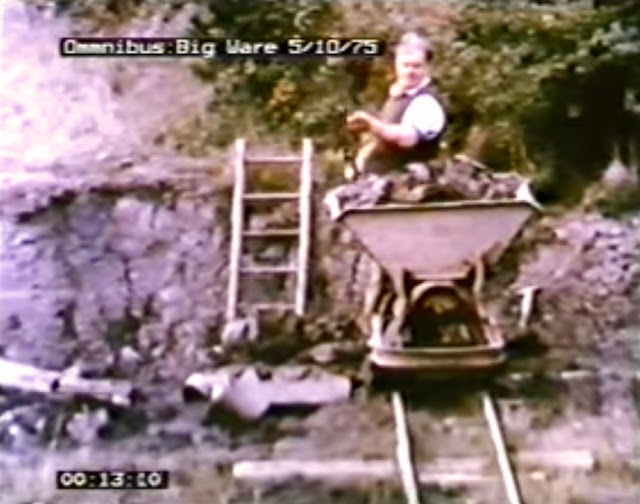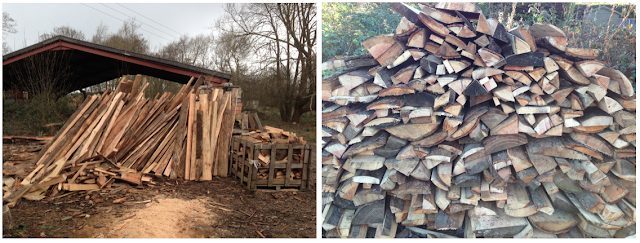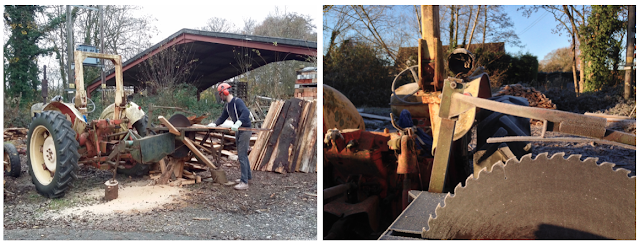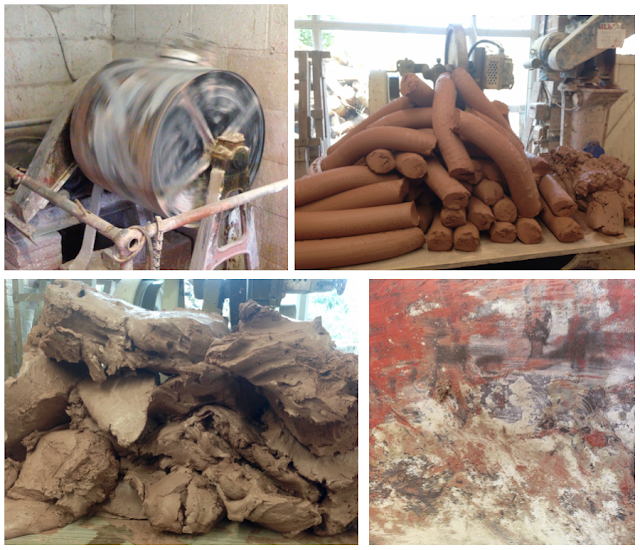In the 1970s and 80s,
David and Sally Shaw-Smith made a series of 37 films for Irish Television company RTÉ that documented the work of people still pursuing traditional crafts in Ireland, "where the emphasis is on the skill of human hands rather than on machines." Beautifully, the title of the series was, simply, Hands. One of the episodes focusses on Carley's Bridge Pottery in Enniscorthy, County Wexford, the oldest pottery in Ireland, founded in the 1650s by the Carley brothers, originally from Cornwall. Travelling in search of a site for their new pottery, they settled on Enniscorthy because of the quality of the clay they found there. It is the same clay that we see being dug out of the ground in the film. A strikingly large amount of the documentary is devoted to the back-breaking labour of digging up and preparing the clay - repetitive, tiring work, carried out here with quiet skill and precision. The filmmakers were obviously captivated by the process. Drudgery, in the hands of skilled, hard-working people, becomes worthy of our attention.
 |
| Stills of three workers, James, John and Tom, digging the clay at Carley's Bridge |
It is a beautiful, gentle film that quietly celebrates a working pottery in the country tradition - using material sourced on-site in order to produce humble domestic wares and plant pots for the local community. Pots with an intended use and a healthy, ready market. It represents a craft and trade that, even at the time of filming, was being left behind by other manufacturing processes - much like the utterly
wonderful documentary of George Curtis at
Littlethorpe Pottery. Country pottery (as I am learning!) is one of the main roots of what we do today. Obviously society has changed a lot in a hundred odd years, and the cultural position of pots within it, but I still think there is much to be held up to the light from those times, including a deep integrity that cannot be mimicked, but perhaps that is for another post.
 |
| George Curtis digging clay at Littlethorpe |
Both of the films portray the exertions and rewards of hard work. It is very easy to become romantic about all of this, but I do not think it is a danger as it can be elsewhere with culture. Most potters working today, I would guess, would consider themselves to be at least a little bit romantic, otherwise they would probably not undertake such a difficult, precarious way of making a living. There is great risk in making a good pot, everyone knows it is very easy for things to go wrong in pottery, but the best pots lie on the very edge of that risk - every now and again, between the throwing, the glazing, the firing and a touch of something beyond your control, a pot will come out of the kiln that takes your breath away. David Pye's well-known distinction between things that are mass-produced and things that are made by hand is the difference between certainty and risk. The workmanship of risk, and the potential for these wonderful moments, relies on, he says, the "judgment, dexterity and care" of the maker. If you wanted to be very romantic about it, it is the combination of head, hands and heart.
In Vincent Van Gogh's The Potato Eaters, he strived to show the reality of people at the end of a hard day of work. He felt that he could best show this through his depiction of their hands.
"You see, I really have wanted to make it so that people get the idea that these folk, who are eating their potatoes by the light of their little lamp, have tilled the earth themselves with these hands they are putting in the dish, and so it speaks of manual labour and — that they have thus honestly earned their food."
A great deal of the work involved in making pottery is drudgery. There are dozens and dozens of small, laborious, in-between but essential jobs that need to be done. There is definitely a simple joy to physical hard work in its own right and to getting to the end of a day's work and looking at what you have achieved. But there is also a more subtle satisfaction that comes from the understanding of all your cumulative labour adding up to something bigger.
 |
| Pine waiting to be cut and a temporary pile of wood cut to length, waiting to be stacked into palettes |
At Winchcombe, we mix clay and glazes and fire with wood. And these jobs get completed steadily, bit-by-bit, over days and days, in between throwing, turning, glazing and firing. On their own they might seem very distant from a lot of people's idea of what being a potter is like - day after day sat joyfully at the wheel throwing pot after beautiful pot, creating all the time. The truth is that throwing on the wheel actually makes up a relatively small percentage of what a potter does. There is an enormous amount of labour that happens before, alongside and after throwing in order to make beautiful work in a pottery.
 |
| The handsome tractor at Winchcombe |
 |
| Me cutting the wood on the saw and the blade with some early morning frost |
One of the very first tasks I was asked to do when I started at Winchcombe was stacking wood into palettes, a full day of it. We fire our kiln with wood and it is enormously labour intensive, both during the firing and leading up to it. We get through roughly two palettes per firing and we generally fire the kiln once a month. It is hard work cutting and stacking the wood and we often have to devote a full day or two to it all in order to get through each new delivery from the sawmill. The wood needs to be cut to length for the firebox in the kiln, stacked and then seasoned for roughly a year before it is ready.
 |
| Clockwise from top left: The ball mill in action, mixing up a glaze; pugs of clay waiting to be passed through the pug-mill for a second time; a pile of the mixed clay body before it is pugged; the inside of the mixer, showing the powder clay and red iron sticking to the sides. |
Glazes and slips need to be mixed, with the raw materials combined in a ball mill, the mixture sieved, and the right consistency achieved depending on the glaze. The kiln needs to be made ready, kiln shelves dusted with alumina, plate stacks put together, ash pits cleared. Bats and boards need to be scraped and sponged clean. I have also spent almost whole working days sieving sand - literally sieving out any small stones or larger grains so that only the finer material is left, but it all adds up. The sieved sand is combined with two types of clay and iron oxide in a mixer before it is left to mature (at Winchcombe, we use a wonderful Victorian dough mixer that was bought from the bakers in the town). Then the clay will be processed in a pug-mill before being ready to throw with.
 |
| The beautiful colours of the pine and splitting the wood by hand when it is too wide for the fireboxes. |
All of these things and more need to be done within a cycle of making that leads up to a firing. So the cycles get repeated, month after month. These jobs are never done for good, they will always need doing again soon. Even though our pots often have an individual maker's mark alongside the WP stamp, every single pot that we produce at Winchcombe will have passed through all of our hands and will represent all of our work. The work becomes devotional - intense concentration and care with the immediate task at hand, knowing that it is adding up to something much bigger. The hard work of it all, knowing this, becomes deeply satisfying. A finished, beautiful pot represents all of the accumulated hours of this collective judgment, dexterity and care.
Joseph Fuller









No comments:
Post a Comment